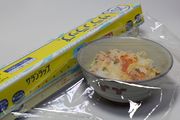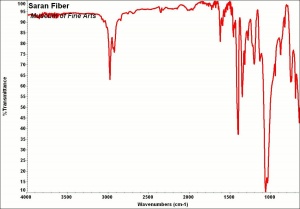Difference between revisions of "Saran film"
| Line 43: | Line 43: | ||
* Pam Hatchfield, ''Pollutants in the Museum Environment'', Archetype Press, London, 2002 | * Pam Hatchfield, ''Pollutants in the Museum Environment'', Archetype Press, London, 2002 | ||
| − | * Wikipedia | + | * Wikipedia: http://en.wikipedia.org/wiki/Saran_%28plastic%29 (Accessed Sept. 14, 2005) |
[[Category:Materials database]] | [[Category:Materials database]] | ||
Revision as of 12:02, 15 June 2022
Description
[SC Johnson] Originally a Dow Chemical tradename for thermoplastic film copolymer of vinylidene chloride and small amounts of vinyl chloride or acrylonitrile. Polyvinylidene, or PVDC, was discovered by accident in 1933, by Ralph Wiley a college student working at Dow. The name Saran was trademarked by Dow Chemical in 1940, but has now become a commonly used name for thin plastic films used primarily to cover food. The PVDC films have a very low water permeability, is very inert and can withstand high temperatures. It has good chemical resistance to acids and alkalis and does not lose strength in sunlight. Saran plastic is used for fibers, packaging films and acid-resistant pipes.
In 1998, the SC Johnson bought Saran Wrap from Dow. In 2004, due to environmental conserns, SCJ decided to remove chorine from all of their products. As a result, 'Sraran wrap' was reformulated as a Polyethylene film that is modifed to contain some Polybutylene as a cling agent. The polybutylene also allows the polyethylene to withstand higher temperatures, such as those produced by steam in a microwave. The reformulated product does not perform as well as PVDC, and thte company lost significant sales due to the change, but the SJC CEO siad it was the right thing to do (Link).
Synonyms and Related Terms
Saran wrap; plastic wrap
Applications
Personal Risks
Nonflammable.
Collection Risks
Physical and Chemical Properties
Resistant to acids, alkalis. May be damaged by ketone, carbon tetrachloride, ethanol, perchloroethylene Resistant to insects and bacteria.
For 1 mil film:
- Oxygen transmission = 12-16 ml/m2d
- Water vapor transmission = 3.8 g/m2d
- Melting Point = 160--177 C
- Density = 1.17
Additional Information
° SC Johnson: Website
° The History of Saran Wrap: Website
Sources Checked for Data in Record
- G.S.Brady, Materials Handbook, McGraw-Hill Book Co., New York, 1971 Comment: p. 850
- Rosalie Rosso King, Textile Identification, Conservation, and Preservation, Noyes Publications, Park Ridge, NJ, 1985
- Pam Hatchfield, Pollutants in the Museum Environment, Archetype Press, London, 2002
- Wikipedia: http://en.wikipedia.org/wiki/Saran_%28plastic%29 (Accessed Sept. 14, 2005)

